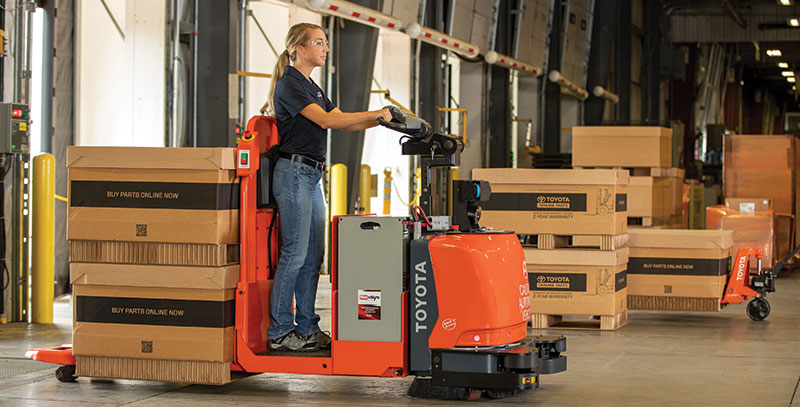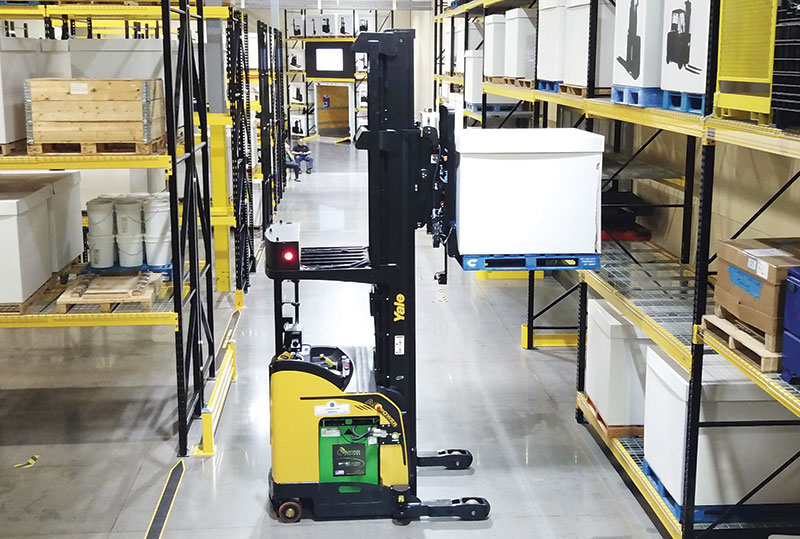Getting started
Despite the tight labor market and technological improvements, obtaining an ROI with automated lift trucks is not a slam dunk. Prices have come down—and an autonomous lift truck is likely to be less expensive than a purpose-built AGV—but they are not yet on par with a conventional lift truck. And, as Raymond’s David Norton points out, when they are in use, autonomous lift trucks are typically required to move at slower speeds for safety reasons. “Right now, it’s a tall order to compete with an efficient operator” on tasks like putaway into a pallet rack, he says.
![]()
One of the advantages of autonomous lift trucks is that they can operate in dual mode: Autonomously, like an AGV, or with an operator during peak times.
The result is that, as is the case with other technologies, introducing autonomous lift trucks isn’t just a matter of replacing a manual operation with technology. Here are four steps you should consider before implementing autonomous lift trucks.
Step 1. Make sure your existing processes and warehouse practices are rock solid. “You don’t want to automate a bad process,” says Norton. A good start is to walk the floor to assess housekeeping practices that could impede automation. For instance, look for stretch-wrap or corrugated on the floor; pallets in the aisles; or misaligned or poorly built pallets in racks that may not work well with automation.
Step 2. If your facility is capturing telematics, analyze the operational data of your existing lift truck fleet to better understand how your vehicles are being used. Are your reach trucks doing a lot of traveling, for instance? “When you look at the data, you can see where there is congestion that is impacting the flow of material through your facility,” says Norton. That analysis may result in simply making better utilization of the existing fleet, but might also uncover areas where automation can make a difference.
Step 3. How many shifts are you operating; how many people do you need for the processes you may be able to automate—especially on second and third shifts; and what is the labor market like in your area? The more shifts, the easier it is to leverage the investment.
Step 4. Map out all of the movements within the facility. “You want to make an intelligent decision about where you use autonomous lift trucks and where not to use them,” says Thompson. And she adds: Definitely start small and avoid complexity until you have experience with the technology. Remember that automation is about more than simply converting a manual process to an automated process. “You have to look at the impact on your upstream and downstream processes,” says Toyota Advanced Logistics’ Augst.
![]()
The next generation of autonomous lift trucks are capable of automated putaway and retrieval of pallet loads.
Where we go from here
Without question, interest is growing in autonomous lift trucks, but they remain a niche solution in today’s market—after all, millions of conventional vehicles are in operation compared to thousands of autonomous vehicles. And, “keep it simple” is the mantra for anyone that might want to stick their toe in the water. But the technology is making strides, and lift truck providers and consultants are already looking at what comes next.
Thompson believes the next move will be to expand autonomous lift truck technologies outside the four walls of a facility to the yard with autonomous truck jockeys to move trailers. “If you’re going to invest in a technology ecosystem for autonomous vehicles, you have to ask what kind of synergies you can gain by supporting both scenarios,” she says. “I think the business case will be easier to make.”
We might also see outdoor travel to link multiple buildings. And, as automatic trailer loading and unloading improves, there’s an opportunity to completely automate receiving and shipping from the yard to the DC.
Inside the four walls, KION’s Zierhut expects to see facilities in which conventional lift trucks, autonomous lift trucks and AMRs co-exist, depending on the application. He also expects to see additional automation capabilities added to lift trucks, such as automating case picking to a pallet.
“A lot is going to change,” adds Jim Gaskell from Crown Equipment. “Talk to us again in a year.”








 粤公网安备 44010602003952号
粤公网安备 44010602003952号